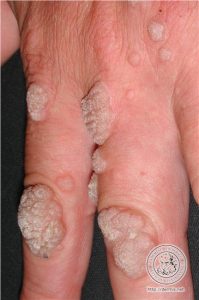SERVICES
- Allergy Screening
- Chemical Peels
- Dermapen
- Facial Skin Analysis
- FreshEyes
- Hyperhidrosis (Excessive Sweating)
- Hair Loss Treatment
- Laser Clinic
- Liquid Facelift
- Keloid Treatments
- Medical Facials
- Medical Treatments
- Mole Mapping
- Photodynamic Therapy (PDT)
- Skincare Advice
- Pigmentation Treatment
- Surgical Procedures
- Ultraviolet Phototherapy
USEFUL LINKS
Warts are tumours or growths of the skin caused by infection with Human Papillomavirus (HPV). More than 70 HPV subtypes are known. Warts are particularly common in childhood and are spread by direct contact or autoinocculation. This means if a wart is scratched, the viral particles may be spread to another area of skin. It may take as long as twelve months for the wart to first appear.
 What do they look like?
What do they look like?
Warts have a hard ‘warty’ or ‘verrucous’ surface. You can often see a tiny black dot in the middle of each scaly spot, due to a thrombosed capillary blood vessel. There are various types of viral wart.
- Common warts arise most often on the backs of fingers or toes, and on the knees.
- Plantar warts (verrucas) include one or more tender inwardly growing ‘myrmecia’ on the sole of the foot.
- Mosaic warts on the sole of the foot are in clusters over an area sometimes several centimetres in diameter.
- Plane, or flat, warts can be very numerous and may be inoculated by shaving.
- Periungual warts prefer to grow at the sides or under the nails and can distort nail growth.
- Filiform warts are on a long stalk.
- Oral warts can affect the lips and even inside the cheeks. They include squamous cell papillomas.
- Genital warts are often transmitted sexually and predispose to cervical, penile and vulval cancer.
In children, even without treatment, 50% of warts disappear within 6 months; 90% are gone in 2 years. They are more persistent in adults but they clear up eventually.
Warts are particularly numerous and troublesome in patients that are immunosuppressed, most often due to medications such as azathioprine or ciclosporin. In these patients, the warts almost never disappear despite treatment.
Treatment
Many people don’t bother to treat them because treatment can be more uncomfortable and troublesome than the warts – they are hardly ever a serious problem. However, warts may be painful and they often look ugly and cause embarrassment. To get rid of them, we have to stimulate the body’s own immune system to attack the wart virus. Persistence with the treatment and patience is essential!
Occlusion
Just keeping the wart covered 24 hours of the day may result in clearance. Duct tape is convenient and inexpensive.
Chemical treatment
Chemical treatment includes wart paints containing salicylic acid or similar compounds, which work by removing the dead surface skin cells. Podophyllin is a cytotoxic agent, and must not be used in pregnancy or in women considering pregnancy.
The paint is normally applied once daily. Perseverance is essential – although 70% of warts will go with wart paints, it may take twelve weeks to work! Even if the wart doesn’t go completely, the wart paint usually makes it smaller and less uncomfortable.
First, the skin should be softened in a bath or bowl of hot soapy water. The hard skin should be rubbed away from the wart surface with a piece of pumice stone or emery board. The wart paint or gel should be applied accurately, allowing it to dry. It works better if covered with plaster or duct tape (particularly recommended when the wart is on the foot).
Stronger preparations such as Upton’s paste are used for thick verrucas, applied every few days. It is important to protect the surrounding skin with adhesive plaster before applying Upton’s paste, and to apply a plaster over the paste to keep it in place.
If the chemical makes the skin sore, stop treatment until the discomfort has settled, then recommence as above. Take care to keep the chemical off normal skin.
3% formalin solution can be used to soak multiple mosaic plantar warts several times a week. Protect unaffected skin with Vaseline, and apply cotton wool soaked in the solution, left in place for about ten minutes before rinsing off.
Cryotherapy
The wart is frozen with liquid nitrogen repeatedly, at one to three week intervals. This is uncomfortable for a few minutes and may result in blistering for several days. Success is in the order of 70% after 3-4 months of regular freezing. Dermatologists debate whether a light freeze to stimulate immunity is sufficient, or whether a harder freeze is necessary to destroy all the infected skin. A hard freeze might cause a permanent white mark or scar.
Electrosurgery
Electrosurgery (curettage & cautery) is used for particularly large and annoying warts. Under local anaesthetic, the growth is pared away and the base burned by diathermy or cautery. The wound heals in about two weeks; even then 20% of warts can be expected to recur within a few months.
Other treatments
- Vaccine Antigen Immunotherapy
- Vaccine Antigen immunotherapy represents a new form of treatment of viral warts.
A vaccine antigen is normally used as a skin test to determine the ability of an individual to develop an immune reaction. It is registered for this use in most countries.
Several studies, published in well-respected journals, have demonstrated that vaccine antigen can be used successfully for the treatment of warts. The first report of its successful use in viral warts came from Japan in 1979. This was followed by studies from the USA where several hundred patients were successfully treated.
Vaccine antigen has been used to treat viral warts in this practice since 2002. One of the amazing features of using vaccine antigen is that although only one wart is treated, all the warts usually disappear. The antigen also confers immunity against the development of further warts, much like a tradionla vaccine.
The procedure successfully gets rid of warts in up to 78% of patients.
Procedure:
0.1ml of the vaccine is injected into a single wart. The wart chosen for injection is usually the largest and often the first wart to have appeared. The injection is repeated in the same wart at 3 week intervals. Occasionally, a larger amount of antigen is injected ie. 0.2 or 0.3ml. and sometimes, other warts are injected. A lack of response 3 months after the 3rd injection is regarded as a treatment failure. In this case, other forms of treatment will be considered. The injection is given using an insulin syringe, which diabetics use to inject themselves. For those that cannot stand the thought of injections, EMLA cream can be used to make the skin numb. Alternatively, the antigen can also be mixed with local anaesthetic. Discuss your tolerance of injections with your doctor.
Side effects of treatment include redness and swelling at the injected site, enlargement of the lymph glands, a flu-like illness which may be easily controlled with Paracetomol, and very rarely, an allergy to the antigen. The practice is geared to handle allergic reactions. You will be observed in the practice for 15 min after the injections.
As with all wart treatments, this procedure is not guaranteed to remove your warts.
Patient Testimonials
EXCELLENTTrustindex verifies that the original source of the review is Google. From my first visit with Dr Jhetam I knew I would go back. He is compassionate , friendly and has an interaction which made you feel comfortable. This is very important in any doctor because our relationship with our doctor is very intimate.Posted onTrustindex verifies that the original source of the review is Google. Dr Jhetman is truly one of a kind. Anyone who is fortunate enough to be in his care can so grateful. Academic, informative and reassuring. It’s hard to find a doctor who has this combination of skills these days. He dealt with my Melonoma concerns with swift and professional care. And his staff are equally as competent and caring. I cannot commend Dr Jhetman and his staff enough on true patient care. Thank you!Posted onTrustindex verifies that the original source of the review is Google. I was absolutely satisfied with my experience with Dr Jhetham & his winning team. Keep up the good work.Posted onTrustindex verifies that the original source of the review is Google. Best skin doctor..Dr Jetham prescribed the best products that have brought so much of a glow to my skin..being a transplant patient and so much happening to my skin just 4 visits to him and my face is back to it's radiance ..I hightly reccomend Dr Jetham ...you won't go wrong..Posted onTrustindex verifies that the original source of the review is Google. Dr. Imraan Jhetam and his team provided exceptional care, showcasing professionalism and compassion in every interaction. Dr. Jhetam took the time to thoroughly explain everything, addressing each of my concerns with empathy and understanding. My experience with him was truly wonderful, and I highly appreciate his dedication to patient care.Verified by TrustindexTrustindex verified badge is the Universal Symbol of Trust. Only the greatest companies can get the verified badge who has a review score above 4.5, based on customer reviews over the past 12 months. Read more



